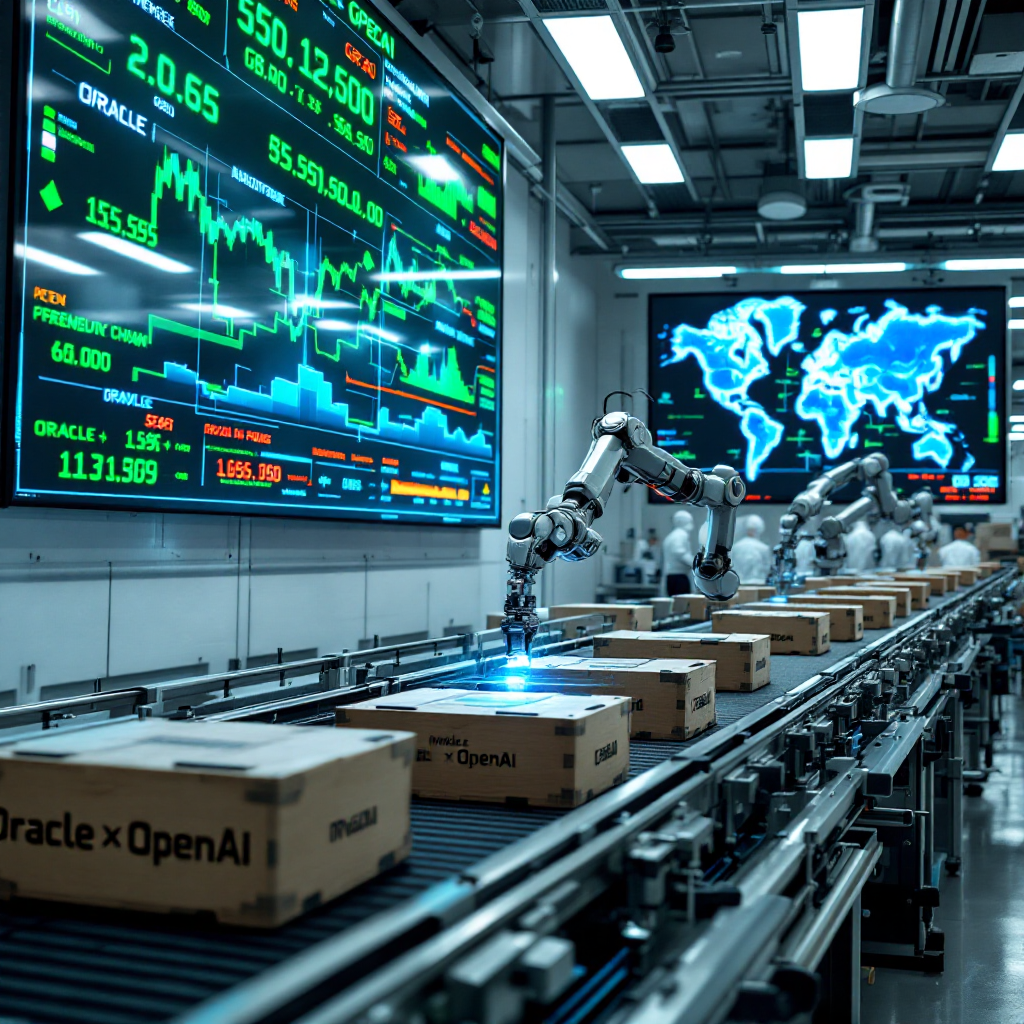The artificial intelligence landscape just witnessed its most significant infrastructure deal in history. OpenAI has confirmed it’s behind Oracle’s eye-popping $30 billion annual contract, marking a seismic shift in how AI companies approach computing power and data center operations.

The Deal That Shocked Silicon Valley
When Oracle disclosed in an SEC filing on June 30 that it had signed a cloud deal generating $30 billion per year in revenue, speculation ran wild about the mystery customer. The revelation that OpenAI was behind this massive contract sent shockwaves through the tech industry.
To put this figure in perspective, Oracle’s entire cloud services revenue for fiscal 2025 was $24.5 billion across all customers combined. This single deal with OpenAI exceeds that amount by $5.5 billion annually.
The announcement caused Oracle’s stock to hit an all-time high, propelling founder and CTO Larry Ellison to become the second richest person in the world, according to Bloomberg. But this isn’t just about one company’s financial windfall it represents a fundamental shift in AI infrastructure strategy.
Stargate: The $500 Billion Vision
This Oracle deal forms part of Stargate, the ambitious $500 billion data center project announced in January 2025. The initiative involves OpenAI, Oracle, and SoftBank, though interestingly, the $30 billion Oracle contract doesn’t involve SoftBank.
OpenAI has revealed that this Oracle partnership will provide 4.5 gigawatts of capacity. According to The Wall Street Journal, this represents the equivalent of two Hoover Dams enough power to supply approximately four million homes.
The scale becomes even more staggering when considering the hardware involved. OpenAI claims the expanded infrastructure will power over 2 million AI chips, creating what could be the world’s most powerful AI supercomputing cluster.
Building the Future in Texas
The first manifestation of this partnership is taking shape in Abilene, Texas, at what OpenAI calls the Stargate I site. This facility represents more than just another data center it’s a proof-of-concept for deploying AI infrastructure at unprecedented scale and speed.
The Abilene facility will house 50,000 Nvidia GB200 accelerators in each of its two initial building complexes, totaling 100,000 Grace CPUs and 200,000 Blackwell accelerators. Construction took less than a year, demonstrating the partners’ ability to execute at breakneck speed.
By mid-2026, the second phase will add six more identical complexes, bringing the total to 400,000 GB200 boards or 800,000 Blackwell accelerators. The complete Abilene facility will require 1.2 gigawatts of electrical energy a massive undertaking that highlights the energy-intensive nature of modern AI operations.
The Economics Behind the Megadeal
The financial implications of this deal are staggering for both companies. OpenAI recently announced it hit $10 billion in annual recurring revenue, up from $5.5 billion last year. Yet this single Oracle commitment costs three times what OpenAI currently brings in annually and that’s before considering all other operational expenses.
For Oracle, the deal represents a massive growth opportunity but also significant risk. The company spent $21.2 billion on capital expenditures in its last fiscal year and expects to spend another $25 billion this year. CEO Safra Catz has indicated this $25 billion figure “may turn out to be understated” as demand continues to surge.
Oracle’s cloud infrastructure revenue was up 51% to $10.2 billion in fiscal 2025, and the company expects this to increase more than 70% in fiscal 2026. The OpenAI deal won’t hit Oracle’s books until 2028, but it’s already driving unprecedented investor confidence.
The Chip Challenge and Supply Chain Dynamics

The deal highlights the critical role of semiconductor supply in AI development. Oracle has reportedly placed a $40 billion order for Nvidia AI GPUs to support the OpenAI partnership, underscoring the massive hardware requirements of modern AI systems.
Nvidia’s GB200 chips, priced at approximately $100,000 each, represent the cutting edge of AI processing power. The company’s data center revenue surged 154% year-over-year to $26.3 billion in Q2 2025, driven largely by demand for these advanced processors.
The concentration of demand around Nvidia’s chips has created both opportunities and challenges. While it reinforces Nvidia’s dominance in AI hardware, it also raises concerns about supply chain bottlenecks and the high cost of entry for new players in the AI space.
Stargate’s Rocky Start
Despite the massive financial commitments, the broader Stargate project has faced challenges. Reports suggest the initiative is off to a slow start, with sources indicating there are still no concrete contracts for new buildings beyond the initial facilities.
The Wall Street Journal reported that Stargate is now planning to build only a single small data center by the end of 2025, likely in Ohio a significant scaling back from the original ambitious timeline. OpenAI and SoftBank have reportedly disagreed over data center locations and the use of SB Energy sites.
Oracle’s Larry Ellison admitted in March that the company had not yet signed contracts for the broader Stargate initiative, highlighting the complexity of executing such massive infrastructure projects.
The Competitive Landscape Heats Up
Oracle and OpenAI aren’t alone in this infrastructure arms race. Meta has accelerated its own data center plans considerably, with reports indicating the company has torn down parts of new buildings because the power supply was inadequate for modern AI requirements.
Meta is designing one new building for one gigawatt capacity, with a second facility announced for 2027 with two gigawatts. CEO Mark Zuckerberg has emphasized the scale by comparing these facilities to Manhattan in size.
This competition reflects the broader recognition that AI infrastructure will be a key differentiator in the coming decade. Companies that can secure reliable, high-performance computing resources will have significant advantages in developing and deploying AI applications.
Energy and Environmental Considerations
The massive power requirements of these AI facilities raise important questions about energy infrastructure and environmental impact. The Abilene facility relies on a combination of local wind energy and gas generators, with Chevron backing the energy infrastructure through investments in Energy No.1.
Crusoe and Lancium, the companies handling power supply for the Oracle-OpenAI facility, have secured options on seven of GE Vernova’s most powerful gas turbines. They’re also working with the Texas government to help stabilize the power grid, which has proven susceptible to outages during extreme weather conditions.
The energy intensity of AI operations is becoming a critical factor in site selection and infrastructure planning. Future facilities will need to balance performance requirements with sustainability goals and grid stability concerns.
Strategic Implications for the AI Industry
This deal represents more than just a business transaction it signals a fundamental shift in AI industry dynamics. OpenAI’s move away from exclusive reliance on Microsoft’s infrastructure demonstrates the importance of vendor diversification as AI workloads scale.
For Oracle, the partnership represents a strategic repositioning from traditional enterprise software to AI infrastructure leadership. The company is betting that its combination of hardware expertise and enterprise relationships will create a sustainable competitive advantage in the AI era.
The deal also highlights the increasing importance of long-term infrastructure partnerships in AI development. Unlike traditional cloud computing, which relies on flexible, on-demand resources, AI training and inference require sustained, high-performance computing over extended periods.
Looking Ahead: The Future of AI Infrastructure

As the AI industry continues to mature, infrastructure partnerships like the Oracle-OpenAI deal will likely become more common. The massive capital requirements and technical complexity of AI data centers favor companies with deep pockets and specialized expertise.
The success or failure of the Stargate initiative will provide important lessons for the broader industry. If Oracle and OpenAI can execute their vision successfully, it could establish a new model for AI infrastructure development and operation.
However, significant challenges remain. The companies must navigate complex regulatory environments, secure reliable energy supplies, and manage the technical complexities of operating massive AI systems at scale.
The Oracle-OpenAI partnership represents a bold bet on the future of artificial intelligence. Whether it pays off will depend on their ability to execute one of the most ambitious infrastructure projects in tech history. What’s certain is that this deal has raised the stakes for everyone in the AI industry, setting new benchmarks for scale, investment, and ambition.
Sources
- TechCrunch – OpenAI agreed to pay Oracle$30B a year for data center services
- Heise Online – OpenAI, Oracle and Meta in the race for the largest gigawatt supercomputers
- OpenAI – Stargate advances with 4.5 GW partnership with Oracle
- RCR Wireless – That$30 billion a year Oracle deal? It’s with OpenAI
- Tom’s Hardware – OpenAI and Oracle ink deal to build massive Stargate data center
- AInvest – Oracle’s 2 million-chip deal with OpenAI: A catalyst for AI-driven cloud infrastructure growth










Comments 2